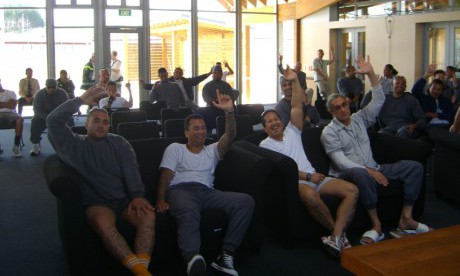For the most part Te Ao Mārama looks just like the other low to medium security units at Waikeria prison. Sixty cells surround a central yard on three sides.
On the fourth is a dining hall, behind that the meeting areas and offices. The perimeter fence is lined with coils of barbed wire, over which fantails dart back and forth, pecking at the grass.
Here, however, pou whenua (traditional posts) which have been carved by inmates, rise from the ground along with the ageing basketball hoop.
Visitors pass through not just the sliding grey security fence, but also the ornate gateway, or waharoa.
For the prisoners, the experience is untypical too, with just about every part of the rehabilitative program underpinned by Māori principles, or tikanga Māori.
Te Ao Mārama (World of Light) is one of five units around the country that make up the Te Tirohanga, or Focus, program.
Together they represent a small attempt to tackle a huge problem: the alarmingly disproportionate quotient of indigenous people locked up in New Zealand prisons.
With 8,500 prisoners among a national population of 4.5 million, New Zealand ranks as one of the highest jailers in the developed world. But as has been repeatedly highlighted in reports by the UN Working Group on Arbitrary Detention, the Māori component is staggering.
While those who identify as Māori make up about 15% of the New Zealand population, the corresponding figure behind bars is more than 50%.
Among women, for whom there is no Te Tirohanga option, it is higher still, at 60%.
The most recent data suggests more than six of every 10 Māori prisoners will be back inside within 48 months.
At its core, the rehabilitation-focused approach of Te Tirohanga is an attempt to interrupt the tendency for jails to act as recruitment centres for gangs and incubators for further criminality. Continue reading
Sources
- Toby Manhire is a former editor of the Guardian comment pages, and the article above was published in The Guardian.
- Image: For the Sake of the Gospel
